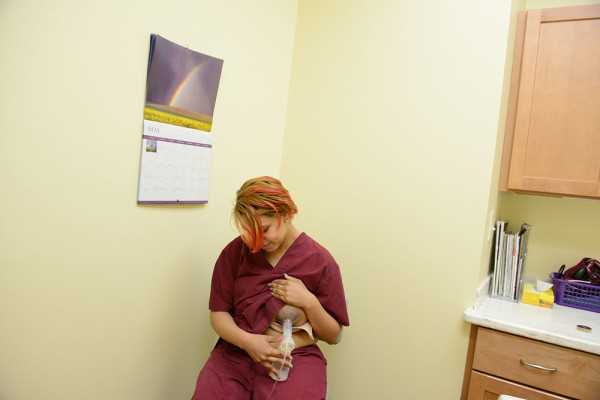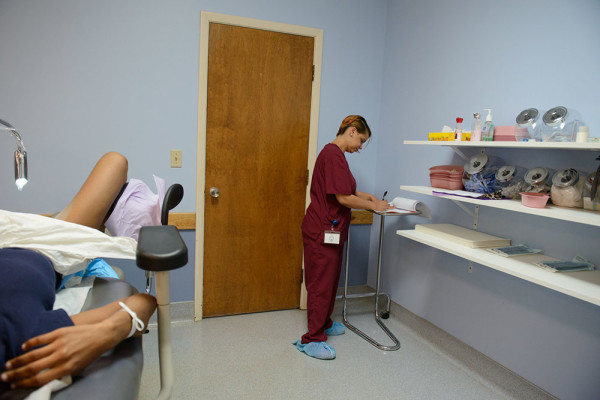Notes
Abortion and Breastfeeding: Both Part of the Ordinary Life of Ordinary Women

Smack in the middle of Alice Proujansky’s twenty-two photographs of “Women Balancing Work and Family” on the New York Times’ Lens blog are two photographs of Kayla Jones. Ms. Jones is a nurse, and the photographs catch her at her workplace, Buffalo Womenservices. The first photograph is a rather ordinary, though intimate, portrait of Jones pumping. She looks down at the slowly filling bottle in her hand with an expression so tender she might as well be looking at her child nursing instead. The room around her is less tender, more ordinary—a calendar tacked on butter-yellow walls, a light switch, a countertop cluttered with journals, tissues, and blood-pressure cuffs. Thanks to the lens or the angle of the camera, the room tilts downward, making the scene feel slightly precarious.
The caption for the photograph then introduces additional information that is both ordinary and extraordinary: Ms. Jones “assists with abortion procedures and gave birth at the Birth Center of Buffalo.” This caption rather abruptly juxtaposes the birth of a wanted child with the end of unwanted (or untenable) pregnancies. In light of that information, the photograph suddenly does the same. Ms. Jones pauses to provide sustenance for her child in a once-bland space suddenly weighted with political import. Here, abortion and breastfeeding become daily labor, both part of the ordinary life of ordinary women.

The next photograph complicates things. In it, Ms. Jones is engaged in her work, “updating a patient’s chart after her abortion.” But Jones both is and is not the main subject of the photograph. While she is the first figure to catch our attention, our eyes are inevitably drawn to the left edge of the photograph and the patient lying on an examining table. Only her right arm, torso, and leg appear. She is anonymous, of course, but a silver light points knowingly between her legs, splayed apart in a position all-too-familiar to any woman who’s had a gynecological exam. These two women—Jones and the patient—balance the photograph from different positions (standing or prone, active or passive) just as they balance work and family in different ways.
Once again, the caption adds another dimension to this balancing, telling us that “The patients receive conscious sedation, which lessens the pain and causes amnesia, but they are aware of the procedure while it takes place.” Like the photograph itself, the caption directs attention away from Ms. Jones and toward the patient. It’s unclear who, exactly, is the subject of the photograph.
In the midst of a photo series about motherhood, the caption also wants us to know that the patient will not remember what it was like to end her pregnancy and this particular chance at motherhood. Is this unnamed woman absolved or indicted by those words? Is Jones? I can’t quite tell. Still, there is something stark, unexpected, and powerful about a serene photograph of abortion in the midst of this series featuring mostly 21st century versions of the Madonna and Child. It reminds us, poignantly, aggressively, that working motherhood is not just a matter of staying on the job through week 36, pumping once the baby arrives, and negotiating childcare with your spouse. It’s also about reproductive freedom. Reviewing these photographs while feeding my own newborn infant, I am reminded that reproductive rights are a crucial part of women balancing work and family. Proujansky doesn’t come right out and say that, but her photograph does.
— Christa Olson | @christajolson
Photos: Alice Proujansky caption 1: Kayla Jones, a 25-year-old nurse, pumping breast milk for her four-month-old baby at Buffalo Womenservices. She assists with abortion procedures and gave birth at the Birth Center of Buffalo. caption 2: Ms. Jones updating a patient’s chart after her abortion at Buffalo Womenservices. The patients receive conscious sedation, which lessens the pain and causes amnesia, but they are aware of the procedure while it takes place.


Reactions
Comments Powered by Disqus